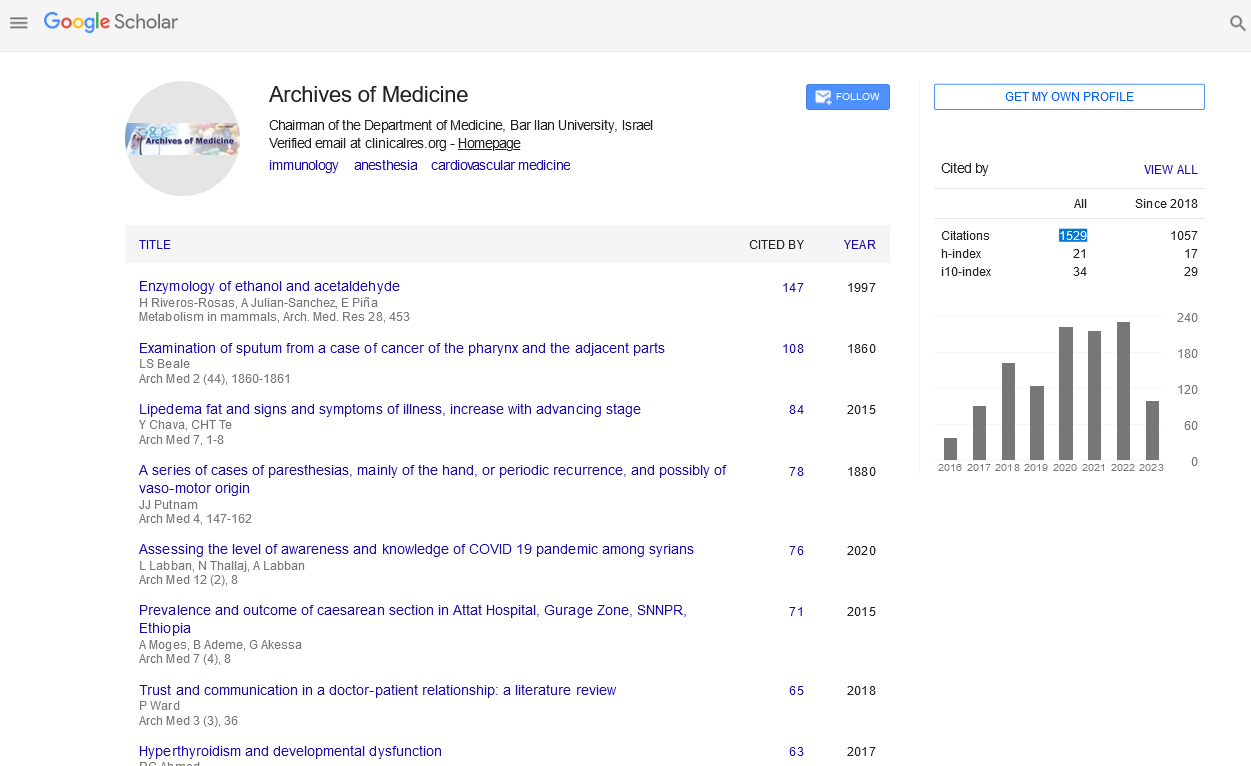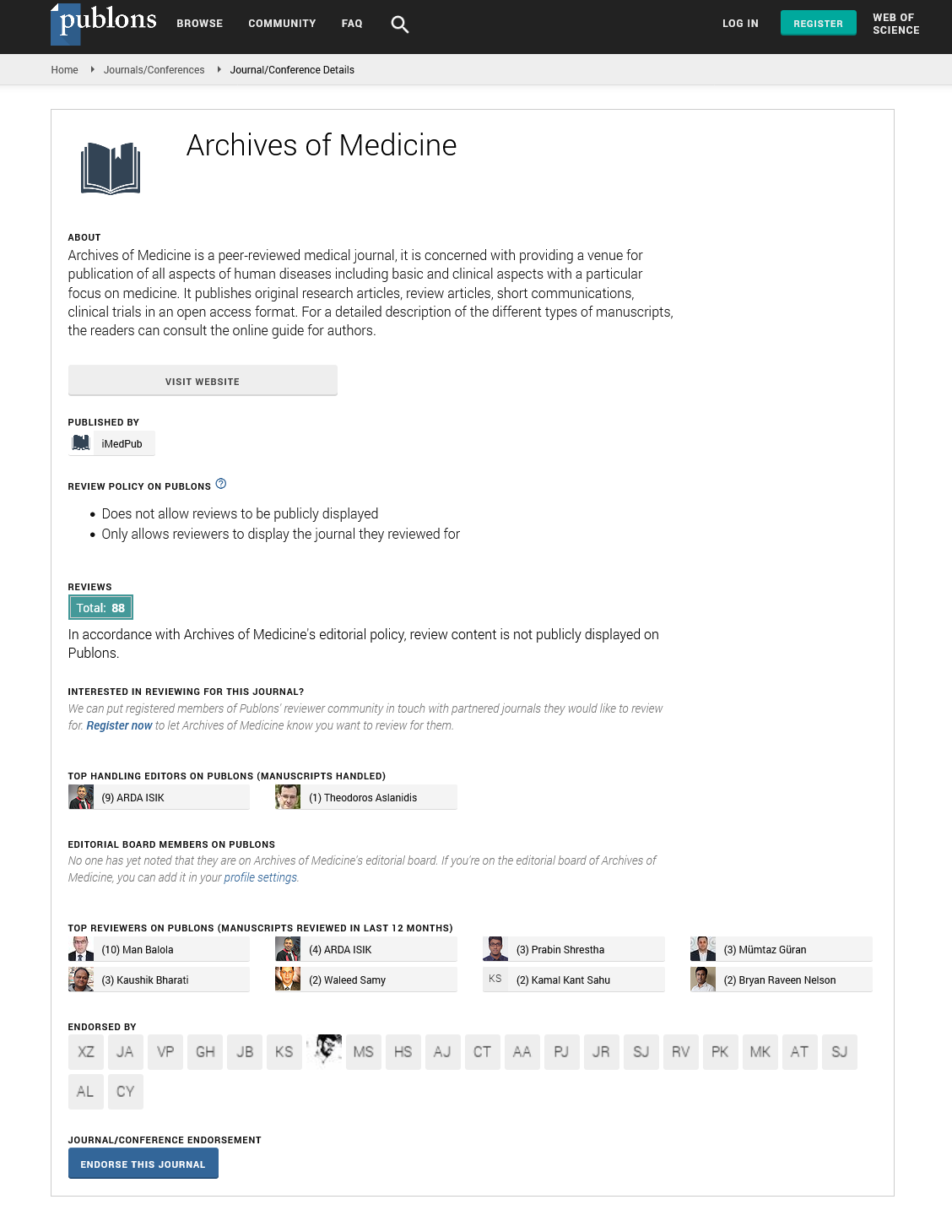Review Article - (2024) Volume 16, Issue 3
Allergic reactions: Decoding the body's immune response
lIrina Vitaly*
Department of Cardiothoracic Surgery, Weill Cornell Medicine New York-Presbyterian Hospital (WCM), New York, USA
*Correspondence:
lIrina Vitaly, Department of Cardiothoracic Surgery, Weill Cornell Medicine New York-Presbyterian Hospital (WCM), New York,
USA,
Email:
Received: 01-May-2024, Manuscript No. ipaom-24-14991;
Editor assigned: 03-May-2024, Pre QC No. P-14991;
Reviewed: 15-May-2024, QC No. Q-14991;
Revised: 22-May-2024, Manuscript No. R-14991;
Published:
29-May-2024
Abstract
An allergic reaction is the body's immune system response to a
substance that it perceives as harmful, even though it's typically
harmless to others. These substances, called allergens, can trigger a
range of symptoms, from mild discomfort to severe, life-threatening
reactions. Allergic reactions can be triggered by a wide variety of
substances, including pollen, pet dander, certain foods, medications,
insect stings, and latex. Symptoms of an allergic reaction can include
sneezing, runny or stuffy nose, itchy or watery eyes, skin rashes or
hives, swelling, difficulty breathing, chest tightness, and anaphylaxis.
Anaphylaxis is a severe, potentially life-threatening allergic reaction
characterized by a sudden drop in blood pressure, difficulty breathing,
and loss of consciousness. It requires immediate medical attention.
Allergies can develop at any age and may vary in severity from person
to person. Treatment for allergic reactions often involves avoiding
triggers, taking antihistamines or other medications to alleviate
symptoms, and in severe cases, carrying an epinephrine auto-injector
for emergency use.
Keywords
Allergen; Immune system; Swelling; Anaphylaxis; Epinephrine; Antihistamines
Introduction
Allergic reactions represent a complex interplay between the body's immune system and external substances known as allergens. These reactions can range from mild discomfort to severe, life-threatening events, impacting millions of individuals worldwide. Understanding the mechanisms underlying allergic responses is crucial for effective diagnosis, management, and prevention of allergic conditions. This comprehensive exploration delves into the intricacies of allergic reactions, decoding the body's immune response to allergens and shedding light on the diverse array of allergic conditions that affect individuals of all ages and backgrounds. Allergic reactions are exaggerated immune responses to otherwise harmless substances, known as allergens that trigger the body's defence mechanisms. While the immune system is designed to protect the body from harmful invaders such as bacteria and viruses, in allergic individuals, it mistakenly identifies certain substances as threats, leading to an immune response. This hypersensitivity reaction can manifest in various organs and tissues throughout the body, resulting in a wide range of symptoms [1].
The prevalence of allergic reactions has been steadily increasing in recent decades, posing significant public health challenges worldwide. According to the World Allergy Organization, allergic diseases affect up to 30-40% of the global population, with rates continuing to rise, particularly in industrialized countries. Common allergic conditions include allergic rhinitis (hay fever), allergic asthma, atopic dermatitis (eczema), food allergies, drug allergies, and insect sting allergies.
Literature Review
The immune response to allergens involves a complex interplay between different components of the immune system, including antibodies, immune cells, and inflammatory mediators. The process typically unfolds in several stages, beginning with sensitization and culminating in the expression of allergic symptoms upon re-exposure to the allergen.
Immune response to allergens
- Sensitization: The initial exposure to an allergen triggers the immune system to produce specific antibodies known as Immunoglobulin E (IgE). These antibodies bind to mast cells and basophils, two types of immune cells that play a central role in allergic reactions. Sensitization primes the immune system to recognize and respond to the allergen upon subsequent exposures.
- Activation: Upon re-exposure to the allergen, cross-linking of IgE antibodies on the surface of mast cells and basophils triggers the release of inflammatory mediators, such as histamine, leukotrienes, and cytokines. These mediators initiate a cascade of immune responses, leading to the recruitment of other immune cells, vasodilation, increased vascular permeability, and tissue inflammation.
- Effector phase: The effector phase of the allergic response is characterized by the expression of clinical symptoms, which vary depending on the site and severity of the reaction. In allergic rhinitis, for example, symptoms may include sneezing, nasal congestion, itching, and watery discharge. In allergic asthma, symptoms may include wheezing, coughing, chest tightness, and shortness of breath. In severe cases, anaphylaxis may occur, leading to systemic symptoms such as hypotension, respiratory distress, and loss of consciousness [2,3].
Types of allergic reactions
Allergic reactions can be classified into several categories based on the underlying mechanisms and clinical manifestations:
- Type I hypersensitivity: Type I hypersensitivity reactions, also known as immediate hypersensitivity reactions, are mediated by IgE antibodies and mast cell activation. These reactions occur rapidly, typically within minutes to hours of allergen exposure, and can involve various organs and tissues. Examples include allergic rhinitis, allergic asthma, atopic dermatitis, food allergies, drug allergies, and insect sting allergies.
- Type II hypersensitivity: Type II hypersensitivity reactions involve the binding of IgG or IgM antibodies to antigens on the surface of cells or tissues, leading to cell destruction or dysfunction. Examples include autoimmune hemolytic anemia, autoimmune thrombocytopenia, and drug-induced cytopenias.
- Type III hypersensitivity: Type III hypersensitivity reactions result from the formation of immune complexes between antibodies and soluble antigens, leading to tissue deposition and inflammation. Examples include serum sickness, systemic lupus erythematosus, and certain drug reactions.
- Type IV hypersensitivity: Type IV hypersensitivity reactions, also known as delayed-type hypersensitivity reactions, are mediated by T cells and occur hours to days after allergen exposure. Examples include contact dermatitis (e.g., poison ivy, nickel allergy), tuberculin skin testing, and certain drug reactions (e.g., contact dermatitis) [4].
Clinical manifestations of allergic reactions
Allergic reactions can manifest in a wide range of clinical symptoms, depending on the type of allergen, route of exposure, and individual susceptibility factors. Common manifestations of allergic reactions include:
- Respiratory symptoms: Allergic rhinitis (hay fever) is characterized by symptoms such as sneezing, nasal congestion, itching, and watery discharge. Allergic asthma may present with symptoms such as wheezing, coughing, chest tightness, and shortness of breath.
- Skin symptoms: Atopic dermatitis (eczema) is a chronic inflammatory skin condition characterized by redness, itching, dryness, and skin lesions. Contact dermatitis may occur in response to exposure to allergens such as plants (e.g., poison ivy), metals (e.g., nickel), or chemicals (e.g., fragrances, cosmetics).
- Gastrointestinal symptoms: Food allergies can cause a range of gastrointestinal symptoms, including abdominal pain, nausea, vomiting, diarrhoea, and difficulty swallowing. In severe cases, food-induced anaphylaxis may occur, leading to systemic symptoms such as hypotension, respiratory distress, and loss of consciousness.
- Cardiovascular symptoms: Anaphylaxis is a severe, potentially life-threatening allergic reaction characterized by a sudden drop in blood pressure, difficulty breathing, and loss of consciousness. Other systemic symptoms may include rapid pulse, chest pain, dizziness, and confusion [5].
Discussion
The diagnosis and management of allergic reactions:
The diagnosis and management typically involve a comprehensive approach that includes:
- Clinical history: A detailed clinical history is essential for identifying potential allergens and triggering factors, as well as assessing the severity and frequency of allergic symptoms.
- Allergy testing: Allergy testing may include skin prick tests, patch tests, blood tests (e.g., specific IgE antibody tests), and oral food challenges to identify specific allergens and confirm the diagnosis of allergic conditions.
- Allergen avoidance: The most effective strategy for managing allergic reactions is to avoid exposure to known allergens whenever possible. This may involve dietary modifications, environmental controls (e.g., air filters, dust mite covers), and lifestyle changes to minimize allergen exposure.
- Pharmacotherapy: Pharmacotherapy options for allergic reactions include antihistamines, corticosteroids, decongestants, leukotriene receptor antagonists, and mast cell stabilizers to alleviate symptoms and reduce inflammation.
- Immunotherapy: Allergen immunotherapy, also known as allergy shots or allergy drops, is a treatment option for individuals with severe allergic rhinitis, allergic asthma, or insect sting allergies. Immunotherapy involves regular administration of gradually increasing doses of allergen extracts to desensitize the immune system and reduce allergic reactions over time.
- Emergency preparedness: Individuals with a history of severe allergic reactions, such as anaphylaxis, should carry an Epinephrine Auto-Injector (e.g., EpiPen) at all times and be trained in its proper use. Prompt administration of epinephrine is essential for reversing the symptoms of anaphylaxis and preventing life-threatening complications [6].
Conclusion
Allergic reactions represent a significant burden on public health, affecting millions of individuals worldwide and impacting their quality of life. Decoding the body's immune response to allergens is essential for understanding the mechanisms underlying allergic reactions and developing effective strategies for diagnosis, management, and prevention. Through continued research, education, and advocacy efforts, we can improve our understanding of allergic conditions, enhance access to allergy testing and treatment, and ultimately, alleviate the burden of allergic diseases on individuals and society as a whole.
Acknowledgement
None.
Conflict of Interest
None.
References
- Nilsson L, Csuth Á, Storsaeter J, et al. Vaccine allergy: Evidence to consider for COVID-19 vaccines. Curr Opin Allergy Clin Immunol. 2021;21(4):401-409.
Google Scholar, Crossref, Indexed at
- Demir S, Erdenen F, Gelincik A, et al. Evaluation of the potential risk factors for drug-induced anaphylaxis in adult patients. Int Arch Allergy Immunol. 2019;178(2):167-176.
Google Scholar, Crossref, Indexed at
- Muñoz-Cano R, Pascal M, Araujo G, et al. Mechanisms, cofactors, and augmenting factors involved in anaphylaxis. Front Immunol. 2017;8:1193.
Google Scholar, Crossref, Indexed at
- Del Rio PR, Pitsios C, Tsoumani M, et al. Physicians' experience and opinion on contraindications to allergen immunotherapy: The CONSIT survey. Ann Allergy Asthma Immunol. 2017;118(5):621-628.
Google Scholar, Crossref, Indexed at
- Ruëff F, Przybilla B, Biló MB, et al. Predictors of side effects during the buildup phase of venom immunotherapy for Hymenoptera venom allergy: The importance of baseline serum tryptase. J Allergy Clin Immunol. 2010;126(1):105-111.
Google Scholar, Crossref, Indexed at
- Chen M, Wu Y, Yuan S, et al. Allergic rhinitis improvement in asthmatic children after using acaricidal bait: A randomized, double-blind, cross-placebo study. Front Pediatr. 2021;9:709139.
Google Scholar, Crossref, Indexed at






